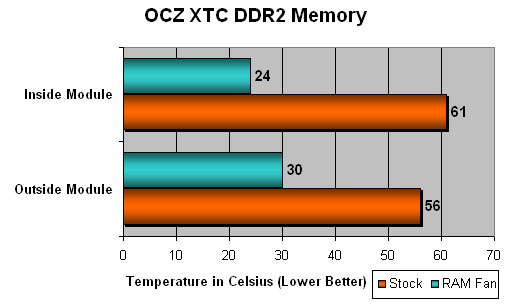The CoolIT Systems RAM Fan Review
Temperature Testing
First up to benchmark was a pair of Corsair XMS2 PC2-6400C3 memory modules that came with the factory black heat spreaders that Corsair Memory has been using for years. After 15 minutes of the R.S.T. PRO2 testing we recorded the surface temperatures of the middle of the heat spreader and the difference was amazing.

The results showed that the CoolIT RAM Fan indeed lowered the temperatures on the heat spreaders by more than half on one of the modules. Without using any cooling fan (stock) the inside module was found to be 59C and the outside module was 55C. The outside module had some airflow around it as the eVGA 680i SLI motherboard uses an active cooling fan that helps move air around. As a result the inside of the modules usually tend to get the hottest.
When using the CoolIT RAM Fan the surface temperature on the modules were found to be drastically cooler. What was strange is the fact that the outside module was now the hottest, but that is due to the angle on the RAM Fan. The RAM Fan blows air across the modules, so the outside module gets the least amount of airflow and the inside modules get the most as they are right under the fan.

When using the OCZ DDR2 modules with the XTC heat spreaders the stock temperatures were found to be a bit warmer, possibly a result that the infrared signal could reach the memory chips (IC’s). When the RAM Fan was installed the temperatures dropped to nearly the same levels as the Corsair XMS2 modules.
It’s clear that the CoolIT RAM Fan makes a huge difference when it comes to cooling and it’s no wonder why memory companies suggest active cooling these days.

Comments are closed.